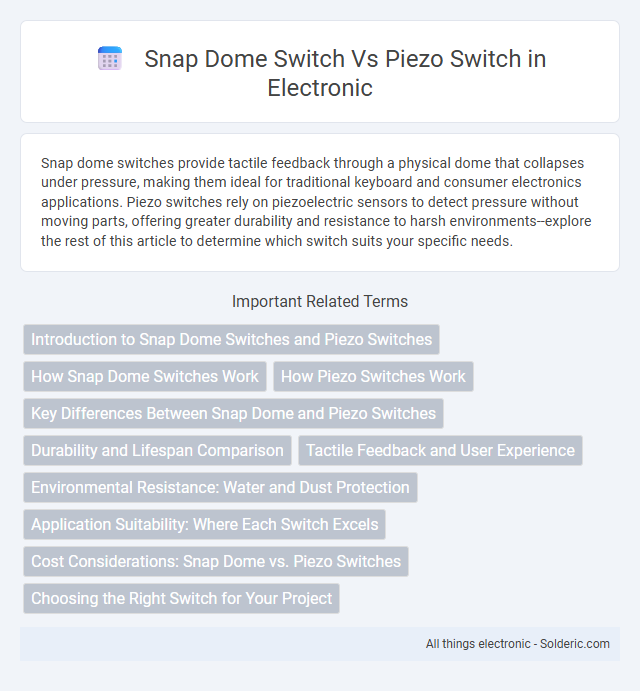Snap dome switches provide tactile feedback through a physical dome that collapses under pressure, making them ideal for traditional keyboard and consumer electronics applications. Piezo switches rely on piezoelectric sensors to detect pressure without moving parts, offering greater durability and resistance to harsh environments--explore the rest of this article to determine which switch suits your specific needs.
Comparison Table
| Feature | Snap Dome Switch | Piezo Switch |
|---|---|---|
| Operating Mechanism | Mechanical snap-action via metal dome | Pressure-induced voltage generation (piezoelectric effect) |
| Durability | Up to 1 million actuations | Over 50 million actuations |
| Force Required | 50-250 grams | Low force, typically under 150 grams |
| Feedback | Tactile click feedback | No mechanical feedback (silent) |
| Environmental Resistance | Moderate; sensitive to dust and moisture | High; sealed, water and dust resistant |
| Size | Compact but thicker than piezo | Extremely thin and flexible |
| Typical Applications | Consumer electronics, keyboards, appliances | Industrial controls, medical devices, harsh environments |
| Cost | Low cost | Higher cost |
Introduction to Snap Dome Switches and Piezo Switches
Snap dome switches operate using a metal dome that collapses when pressed, providing tactile feedback and reliable electrical contact, commonly used in keyboards and control panels. Piezo switches detect pressure changes through piezoelectric materials that generate an electric charge, offering durability and resistance to environmental factors, ideal for industrial and harsh environments. These switches differ significantly in mechanism, application, and durability, with snap dome switches favored for cost-effective tactile response and piezo switches preferred for long life and robustness.
How Snap Dome Switches Work
Snap dome switches operate through a metal dome that collapses when pressed, completing an electrical circuit and providing tactile feedback. This design allows for reliable, quick actuation with a distinct click sensation, commonly used in keyboards and control panels. The mechanical nature of snap dome switches ensures consistent performance and durability over millions of cycles.
How Piezo Switches Work
Piezo switches operate by detecting pressure changes through the piezoelectric effect, where mechanical stress generates an electric charge in the piezo material. Unlike snap dome switches that rely on physical contact and tactile feedback from a metal dome collapsing, piezo switches produce a signal without moving parts, enhancing durability and resisting environmental wear. This non-mechanical operation makes piezo switches ideal for applications requiring long-lasting, reliable touch sensitivity in harsh environments.
Key Differences Between Snap Dome and Piezo Switches
Snap dome switches rely on a metal dome that collapses to complete an electrical circuit, providing tactile feedback with a distinct click, while piezo switches use a piezoelectric element that generates a voltage when pressed, enabling contactless, highly durable operation. Snap dome switches are cost-effective and suitable for high-volume applications but are limited by mechanical wear, whereas piezo switches offer superior longevity, resistance to harsh environments, and require no physical movement to operate. Your choice depends on factors like desired tactile response, environmental conditions, and expected switch lifespan.
Durability and Lifespan Comparison
Snap dome switches typically offer a mechanical lifespan ranging from 1 to 5 million actuations, making them suitable for general use but susceptible to wear over time. Piezo switches utilize solid-state technology with no moving parts, resulting in an exceptional lifespan often exceeding 50 million actuations due to their resistance to mechanical fatigue and environmental factors. This durability advantage makes piezo switches ideal for high-reliability applications demanding long-term performance under harsh conditions.
Tactile Feedback and User Experience
Snap dome switches provide a distinct tactile click due to their metal dome mechanism, offering immediate physical feedback that enhances user confidence during key presses. Piezo switches rely on pressure-sensitive technology without mechanical parts, delivering a smooth, silent activation but less pronounced tactile response. The choice between snap dome and piezo switches directly impacts user experience, balancing the need for feedback clarity against noise levels and switch durability.
Environmental Resistance: Water and Dust Protection
Snap dome switches typically offer moderate water and dust protection, often rated at IP40 to IP54, suitable for standard indoor environments. Piezo switches exhibit superior environmental resistance, commonly achieving IP67 to IP69K ratings, making them highly effective against water ingress and dust contamination in harsh or outdoor conditions. This enhanced sealing capability makes piezo switches ideal for applications requiring robust durability under extreme environmental exposure.
Application Suitability: Where Each Switch Excels
Snap dome switches excel in applications requiring tactile feedback and cost-effective solutions, making them ideal for consumer electronics, remote controls, and membrane keyboards. Piezo switches are suited for harsh environments and industrial applications due to their durability, resistance to moisture and vibration, and ability to operate without physical moving parts. Your choice depends on whether you prioritize tactile response or robust, long-lasting performance in challenging conditions.
Cost Considerations: Snap Dome vs. Piezo Switches
Snap dome switches typically offer lower upfront costs due to simpler materials and manufacturing processes, making them ideal for budget-sensitive projects. Piezo switches, while more expensive initially, provide greater durability and require less maintenance, potentially reducing total cost of ownership over time. Selecting between snap dome and piezo switches hinges on balancing initial investment against long-term performance and reliability demands.
Choosing the Right Switch for Your Project
Snap dome switches offer tactile feedback, low cost, and easy installation, making them ideal for consumer electronics and short lifespan applications. Piezo switches provide high durability, waterproof and dustproof capabilities, and no mechanical wear, best suited for industrial, medical, and outdoor environments requiring reliability. Selecting the right switch depends on project requirements for tactile feedback, environmental resistance, and expected usage frequency.
snap dome switch vs piezo switch Infographic

 solderic.com
solderic.com